Assessment of Economic Efficiency and Its Determents for Mixed Crop Livestock Production under Dryland Agriculture System in the Western Zone of Tamil Nadu, India
Abstract
:1. Introduction
- Represents the nutrient circularity between the soil and plant system, i.e., plant nutrient uptake from soil and a considerable amount of nutrients return to soil through residue incorporation (the system is linear).
- Represents the nutrient circularity between the soil and animal system, i.e., during grazing, the animal waste (urine and dung) adds nutrients to the soil (the system is linear).
- Represents the partial circular system, i.e., combination (a) and (b).
- Represents the complete circular system. This is the combination of an internal (mixed crop–livestock and household) and external system (sale produce). When the production system satisfies the demand of the internal system and excess is supplied to the external system, it is considered to be a complete circular economic production system.
2. Materials and Methods
2.1. Study Area
2.2. Sampling Protocol and Size
- Two blocks from each district were chosen due to their active and assertive participation and involvement in the dryland agricultural system. Based on the concentration of dryland production within the block, two villages were chosen as study sites (Figure 3).
- Farmers were stratified into crop producers (HC), crop with livestock producers (HCL), crop with livestock and bird producers (HCLB), crop with birds, supplementary unit producers (HCBS), crop with livestock, bird, and supplementary unit (HCLBS) producers.
2.3. Data Tracking
2.4. Data Analysis Data Envelopment Analysis (DEA)
2.5. Tobit Regression Analysis
2.6. Data Description and Key Variables
2.7. Statistical Analysis
3. Results
3.1. Principal Component Analysis (PCA)
3.2. Descriptive Statistics
3.3. Data Envelopment Analysis (DEA) of Agricultural Farms
3.4. Tobit Regression Analysis
4. Discussion
- The primary emphasis should be on improving the reuse and redesign strategy and developing new methods for decreasing nutrient wastage. In this regard, the roles of Universities and research institutions should be strengthened.
- The government should create extension services and comprehensive training programmes for agricultural and allied producers regarding the CE strategy.
5. Conclusions
Supplementary Materials
Author Contributions
Funding
Institutional Review Board Statement
Informed Consent Statement
Data Availability Statement
Acknowledgments
Conflicts of Interest
References
- IndiastatAgri. Available online: https://www.indiastat.com/data/agriculture/requirement-availability-and-sales-of-fertilisers (accessed on 10 August 2022).
- IndiastatAgri. Available online: https://www.indiastat.com/data/agriculture/consumption-of-fertiliser-nurtients (accessed on 12 August 2022).
- IndiastatAgri. Available online: https://www.indiastat.com/data/agriculture/fertiliser-prices (accessed on 13 August 2022).
- IndiastatAgri. Available online: https://www.indiastatagri.com/table/labour-workforce/selected-state-wise-average-daily-wage-rates-agric/71279# (accessed on 14 August 2022).
- IndiastatAgri. Available online: https://www.indiastatagri.com/table/labour-and-workforce/monthly-average-daily-wage-rates-harvesting-winnow/841232# (accessed on 16 August 2022).
- Coelli, T. Centre for Efficiency and Productivity Analysis (CEPA) Working Papers; Department of Econometrics, Universíty of New England: Armidale, Australia, 1996. [Google Scholar]
- Raheli, H.; Rezaei, R.M.; Jadidi, M.R.; Mobtaker, H.G. A two-stage DEA model to evaluate sustainability and energy efficiency of tomato production. Inf. Process. Agric. 2017, 4, 342–350. [Google Scholar] [CrossRef]
- Horvat, A.M.; Radovanov, B.; Popescu, G.H.; Panaitescu, C. A two-stage DEA model to evaluate agricultural efficiency in case of Serbian districts. Econ. Agric. 2019, 66, 965–974. [Google Scholar]
- Guney, O.I. Eco-Efficiency in Farm Management for Sustainable Agriculture: A Two-Stage Data Envelopment Analysis in Wheat Production. Pol. J. Environ. Stud. 2021, 30, 5549–5557. [Google Scholar] [CrossRef] [PubMed]
- Rade, P.; Kleut, Z.; Dokic, D. Exploring the drivers of efficiency in organic and conventional soybean production. Custos E Agronegocio 2018, 14, 214–229. [Google Scholar]
- Boubacar, O.; Hui-qiu, Z.; Rana, M.A.; Ghazanfar, S. Analysis on technical efficiency of rice farms and its influencing factors in south-western of Niger. J. Northeast Agric. Univ. 2016, 23, 67–77. [Google Scholar] [CrossRef]
- Ayaz, S.; Anwar, S.; Sial, M.H.; Hussain, Z. Role of agricultural credit on production efficiency of farming sector in Pakistan—A data envelopment analysis. Pak. J. Life Soc. Sci. 2011, 9, 38–44. [Google Scholar]
- Sherzod, B.; Kim, K.R.; Lee, S.H. Agricultural transition and technical efficiency: An empirical analysis of wheat-cultivating farms in Samarkand Region, Uzbekistan. Sustainability 2018, 10, 3232. [Google Scholar] [CrossRef]
- Kwawu, J.D.; Sarpong, D.B.; Agyire-Tettey, F. Technology adoption intensity and technical efficiency of maize farmers in the Techiman municipality of Ghana. Afr. J. Sci. Technol. Innov. Dev. 2022, 14, 532–545. [Google Scholar] [CrossRef]
- Wongnaa, C.A.; Awunyo-Vitor, D.; Mensah, A.; Adams, F. Profit efficiency among maize farmers and implications for poverty alleviation and food security in Ghana. Sci. Afr. 2019, 6, 206. [Google Scholar] [CrossRef]
- Rahman, S.; Kazal, M.M.H.; Begum, I.A.; Alam, M.J. Competitiveness, profitability, input demand and output supply of maize production in Bangladesh. Agriculture 2016, 6, 21. [Google Scholar] [CrossRef]
- Patwa, N.; Sivarajah, U.; Seetharaman, A.; Sarkar, S.; Maiti, K.; Hingorani, K.J. Towards a circular economy: An emerging economies context. J. Bus. Res. 2021, 122, 725–735. [Google Scholar] [CrossRef]
- Doyeni, M.O.; Barcauskaite, K.; Buneviciene, K.; Venslauskas, K.; Navickas, K.; Rubezius, M.; Baksinskaite, A.; Suproniene, S.; Tilvikiene, V. Management of Nitrogen Flow in Livestock Waste System Towards an Efficient Circular Economy in Agriculture. Waste Manag. Res. 2023, 41, 701–712. [Google Scholar] [CrossRef]
- Sutomo, B. Circular Economy on Cattle-Oil Palm Integration System to Realize Sustainable Agriculture (Case Study: District Penawar Aji TulangBawang). Int. J. Environ. Sci. 2022, 7, 14–27. [Google Scholar]
- Singh, E.; Mishra, R.; Kumar, A.; Shukla, S.K.; Lo, S.L.; Kumar, S. Circular economy-based environmental management using biochar: Driving towards Sustainability. Process Saf. Environ. Prot. 2022, 163, 585–600. [Google Scholar] [CrossRef]
- Kuipers, A.; Galama, P.; Leso, L.; Bruegemann, K.; Klopcic, M. A Composting Bedding System for Animals as a Contribution to the Circular Economy. Processes 2022, 10, 518. [Google Scholar] [CrossRef]
- Kamar Zaman, A.M.; Yaacob, J.S. Exploring the potential of vermicompost as a sustainable strategy in circular economy: Improving plants’ bioactive properties and boosting agricultural yield and quality. Environ. Sci. Pollut. Res. 2022, 29, 12948–12964. [Google Scholar] [CrossRef]
- Mukhtar, U.; Mohamed, Z.; Shamsuddin, M.N.; Sharifuddin, J.; Iliyasu, A. Application of data envelopment analysis for technical efficiency of smallholder pearl millet farmers in Kano state, Nigeria. Bulg. J. Agric. Sci. 2018, 24, 213–222. [Google Scholar]
- Long, L.K. Cost efficiency analysis in aquaculture: Data envelopment analysis with a two-stage bootstrapping technique. Aquac. Econ. Manag. 2022, 26, 77–97. [Google Scholar] [CrossRef]
- Nkegbe, P.K. Credit access and technical efficiency of smallholder farmers in Northern Ghana: Double bootstrap DEA approach. Agric. Financ. Rev. 2018, 78, 626–639. [Google Scholar] [CrossRef]
- TNAU Agritech Portal, Agriculture, Soil: Types of Soil-Agroclimatic Zones. Available online: https://agritech.tnau.ac.in/agriculture/agri_soilresource_agroclimate.html (accessed on 24 November 2022).
- District Census Handbook 2011. Available online: https://coimbatore.nic.in/document/census-handbook-2011/ (accessed on 24 November 2022).
- District Census Handbook 2011. Available online: https://tiruppur.nic.in/document/census/ (accessed on 24 November 2022).
- District Census Handbook 2011. Available online: https://erode.nic.in/documents/census/ (accessed on 24 November 2022).
- District Census Handbook 2011 (Part–A). Available online: https://karur.nic.in/document/district-census-handbook-2011-part-a/ (accessed on 24 November 2022).
- District Census Handbook 2011. Available online: https://censusindia.gov.in/nada/index.php/catalog/1121 (accessed on 24 November 2022).
- TNAU Agritech Portal, Agriculture, Agrometerology, Cropping Pattern, Western Zone. Available online: https://agritech.tnau.ac.in/agriculture/agri_agrometeorology_croppingpattern_westernzone.html (accessed on 24 November 2022).
- Multidimensional Poverty Index for Tamil Nadu. State Planning Commmission; Government of Tamilnadu: Chennai, India, 2022; pp. 4–11. Available online: https://spc.tn.gov.in/spc_reports/MDPI_FTM.pdf (accessed on 24 November 2022).
- Government of Tamil Nadu. Available online: https://cms.tn.gov.in/sites/default/files/documents/agri_e_pn_2022_23.pdf27 (accessed on 17 August 2022).
- Coelli, T.J.; Rao, D.S.P.; O Donnell, C.J.; Battese, G.E. An Introduction to Efficiency and Productivity Analysis, 2nd ed.; Springer Science and Business Media: New York, NY, USA, 2005; pp. 41–81. [Google Scholar]
- Koc, B.E.A.; Gul, M.; Parlakay, O. Determination of technical efficiency in second crop maize growing farms in Turkey: A case study for the East Mediterranean in Turkey. Asian. J. Anim. Vet. Adv. 2011, 6, 488–498. [Google Scholar] [CrossRef]
- Thomas, W.Y. The VGAM Package for Categorical Data Analysis. J. Stat. Softw. 2010, 32, 1–34. [Google Scholar]
- R Core Team. R. A Language and Environment for Statistical Computing; R Foundation for Statistical Computing: Vienna, Austria, 2022; Available online: https://www.R-project.org/ (accessed on 19 October 2022).
- Kleih, U.; Ravi, S.B.; Rao, B.D.; Yoganand, B. Industrial Utilization of Sorghum in India; Working Paper Series No. 4. Patancheru 502 324; International Crops Research Institute for the Semi-Arid Tropics: Patancheru, India, 2000; p. 44. [Google Scholar]
- Mundia, C.W.; Secchi, S.; Akamani, K.; Wang, G.J. A regional comparison of factors affecting global sorghum production: The case of North America, Asia and Africa’s Sahel. Sustainability 2019, 11, 2135. [Google Scholar] [CrossRef]
- Staggenborg, S.A.; Dhuyvetter, K.C.; Gordon, W.J. Grain sorghum and corn comparisons: Yield, economic, and environmental responses. Agron. J. 2008, 100, 1600–1604. [Google Scholar] [CrossRef]
- Nematpour, A.; Eshghizadeh, H.R.; Zahedi, M.J. Comparing the corn, millet and sorghum as silage crops under different irrigation regime and nitrogen fertilizer levels. Int. J. Plant Prod. 2021, 15, 351–361. [Google Scholar] [CrossRef]
- Almodares, A.; Jafarinia, M.; Hadi, M. The effects of nitrogen fertilizer on chemical compositions in corn and sweet sorghum. Am. Eurasian J. Agric. Environ. Sci. 2009, 6, 441–446. [Google Scholar]
- Chapke, R.R.; Tonapi, V.A.J. Adoption and socio-economic benefits of improved post-rainy sorghum production technology. Agric. Res. 2019, 8, 270–278. [Google Scholar] [CrossRef]
- Suresh, K.; Chandrakanth, M. Economic efficiency of improved red gram variety (BRG-2) in Karnataka: A DEA analysis. Econ. Aff. 2016, 61, 81–88. [Google Scholar] [CrossRef]
- Gulati, A.; Ganguly, K.; Wardhan, H. Agricultural Value Chains in India, Ensuring Competitiveness, Inclusiveness, Sustainability, Scalability, and Improved Finance; Springer Nature: Singapore, 2022. [Google Scholar]
- Krishi Jagran. Available online: https://krishijagran.com/featured/backyard-poultry-farming-a-low-input-business-with-high-economic-returns/ (accessed on 11 August 2022).
- IndiastatAgri. Available online: https://www.indiastat.com/table/agriculture/state-wise-farm-harvest-prices-principal-crops-sea/1433367# (accessed on 2 January 2023).
- Sukrutha, B.; Akkareddy, S.; Vemireddy, L.; Kumar, A.N.; Latha, P.; Nagamadhuri. Identification of multi-trait donor sources in groundnut (Arachis hypogaea L.) for yield and seed quality improvement. Electron. J. Plant Breed. 2022, 13, 1024–1035. [Google Scholar]
- Priyadharshini, C.; Gnanachitra, M.; Balachandar, D.; Jayanthi. Assessment of Shelf-life and Efficacy of the Seed-Coating Delivery System of Biofertilizers in Maize. Int. J. Plant Soil Sci. 2022, 34, 548–558. [Google Scholar] [CrossRef]
- Elangovan, M.; Annapurna, A.; Patil, R.; Patroti, P.; Pandey, S.; Pandey. Characterization of 2500 Indigenous Collections of sorghum (Sorghum bicolar L.) germplasm. Indian J. Plant Genet. Resour. 2020, 33, 295–299. [Google Scholar] [CrossRef]
- Yevu, M.; Onumah, E.E. Profit efficiency of layer production in Ghana. Sustain. Futures 2021, 3, 100057. [Google Scholar] [CrossRef]
- Paramesh, V.; Ravisankar, N.; Behera, U.; Arunachalam, V.; Kumar, P.; Solomon Rajkumar, R.; Dhar Misra, S.; Mohan Kumar, R.; Prusty, A.; Jacob, D. Integrated farming system approaches to achieve food and nutritional security for enhancing profitability, employment, and climate resilience in India. Food Energy Secur. 2022, 11, e321. [Google Scholar] [CrossRef]
- Beshir, H.; Emana, B.; Kassa, B.; Haji, J. Economic efficiency of mixed crop-livestock production system in the north eastern highlands of Ethiopia: The stochastic frontier approach. J. Dev. Agric. Econ. 2012, 1, 10–20. [Google Scholar]
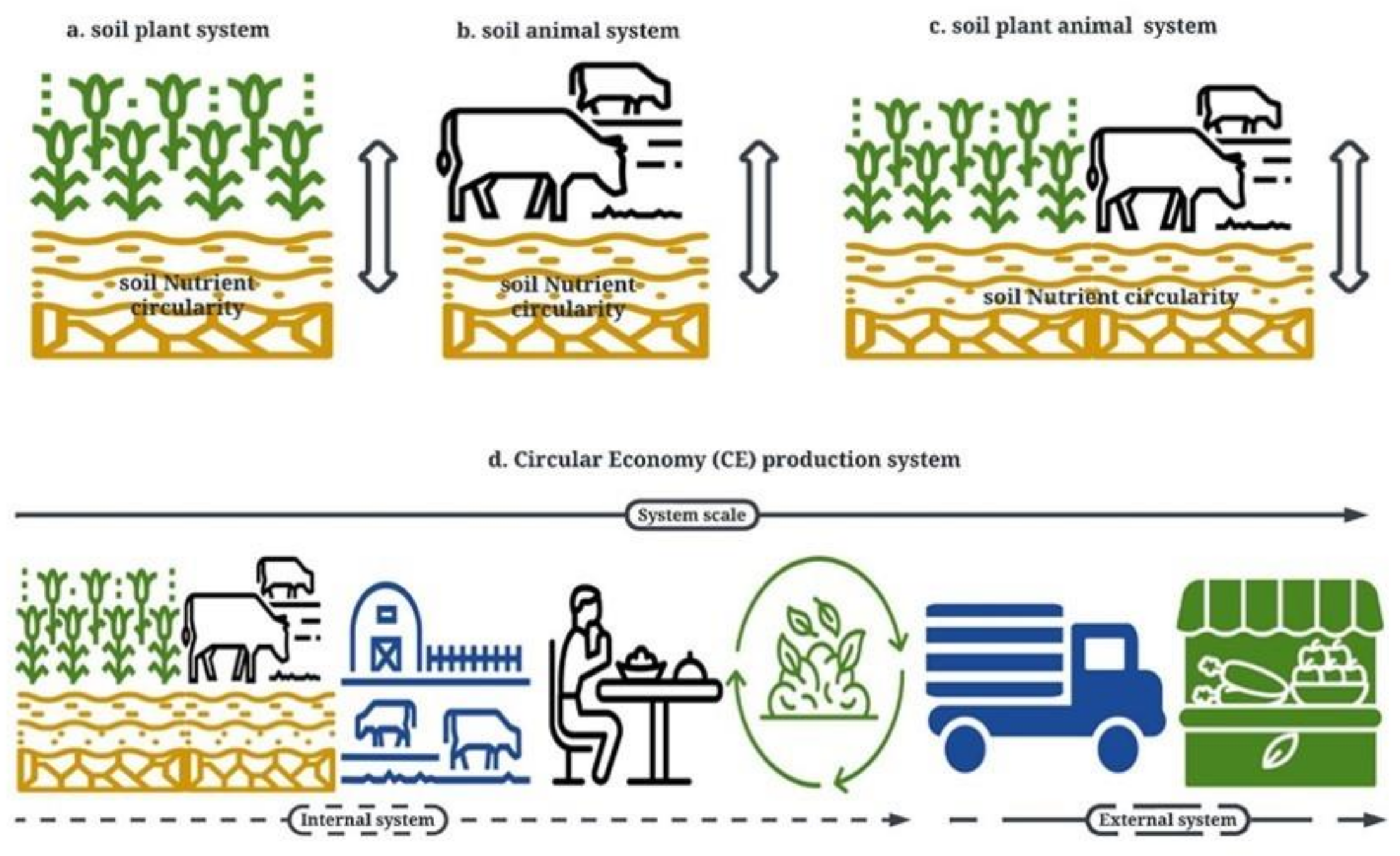

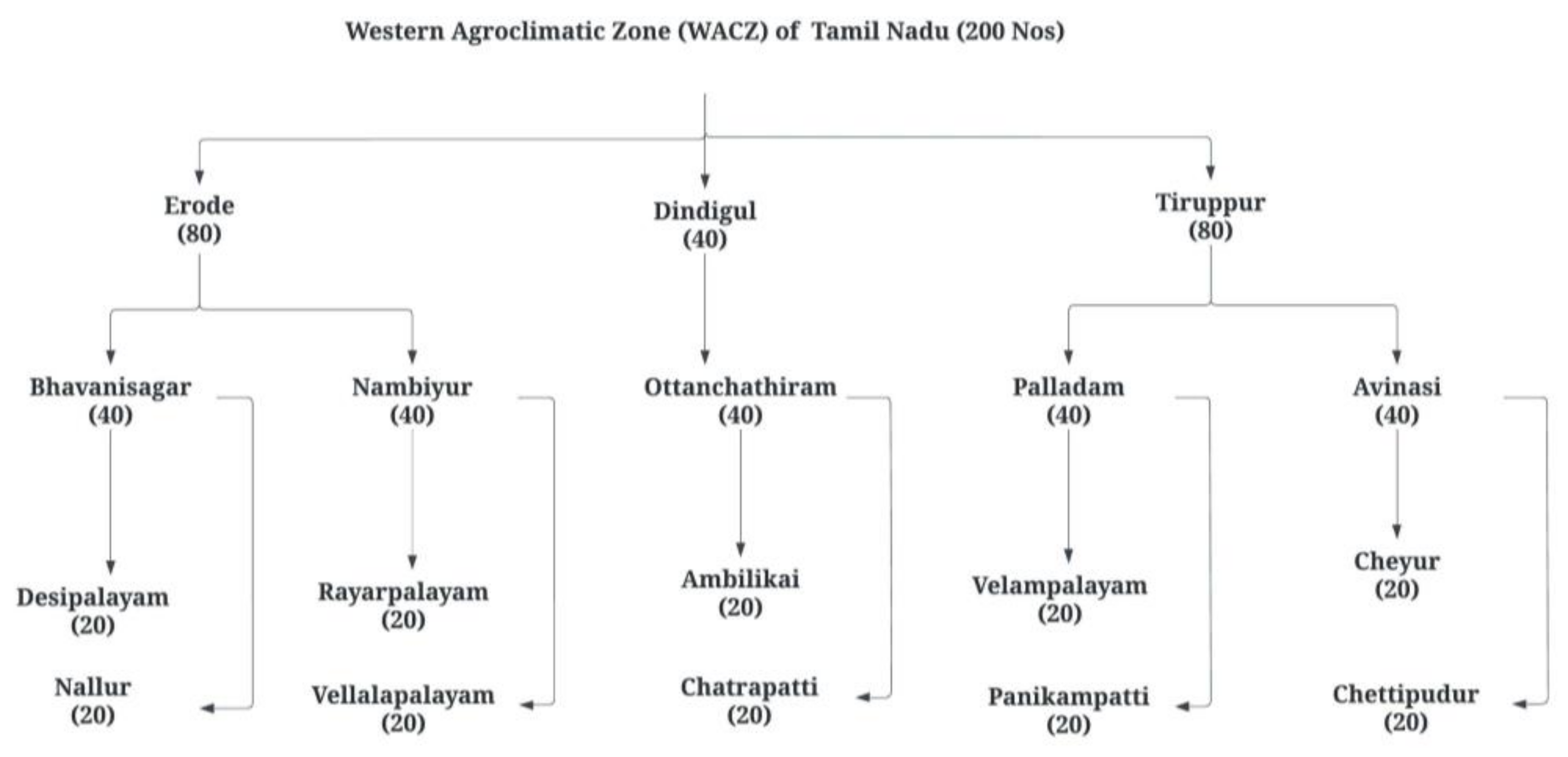
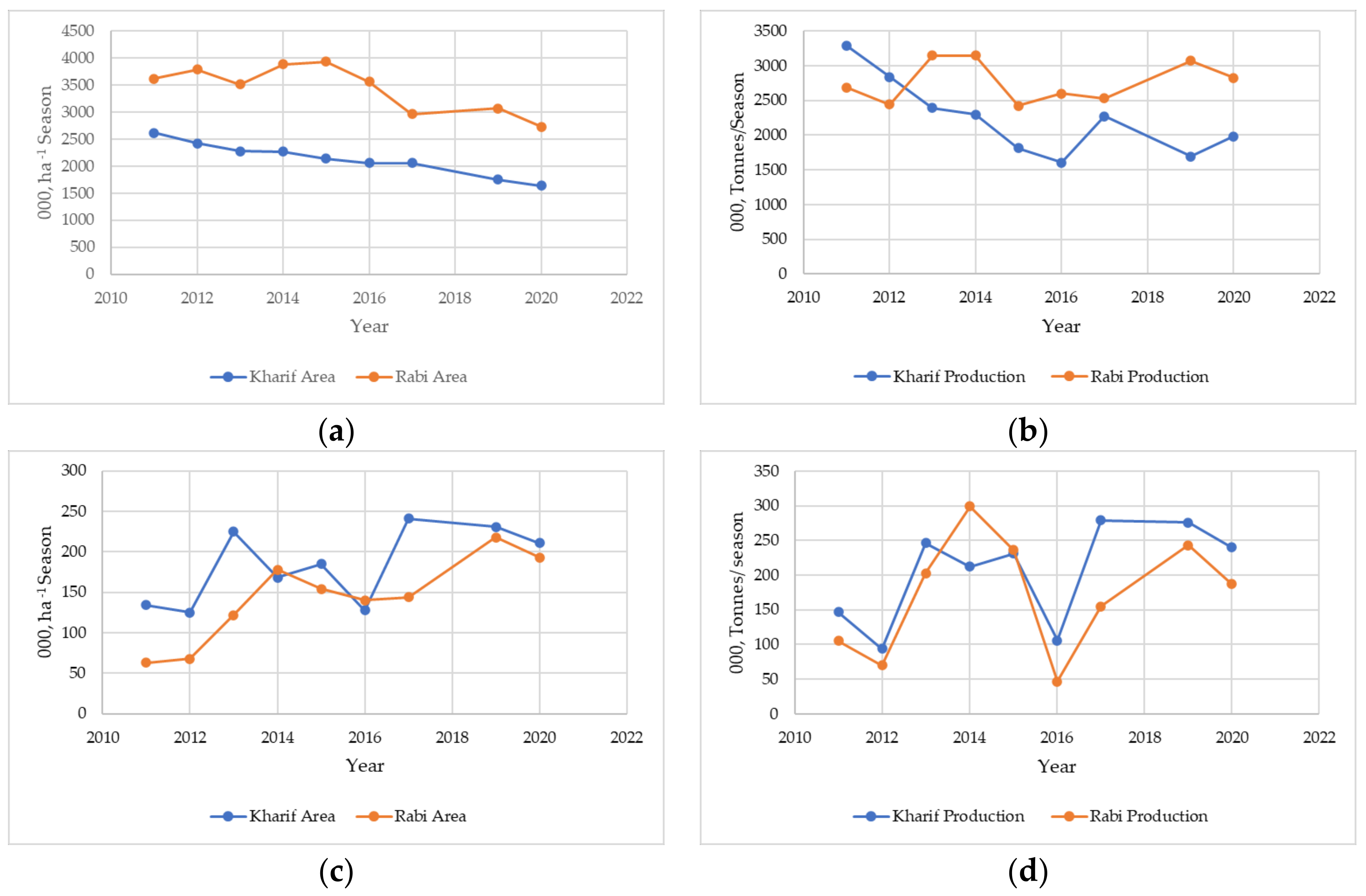


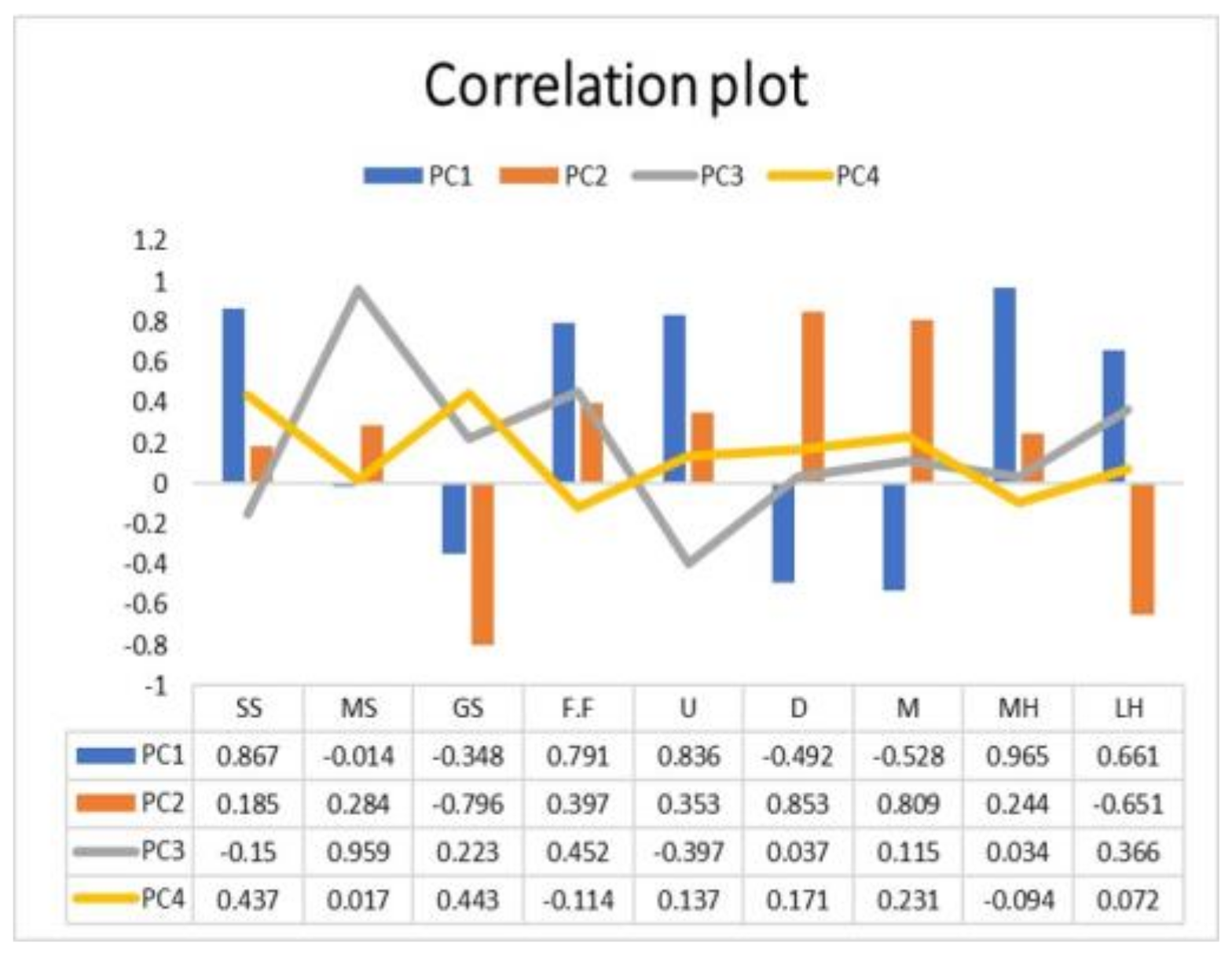
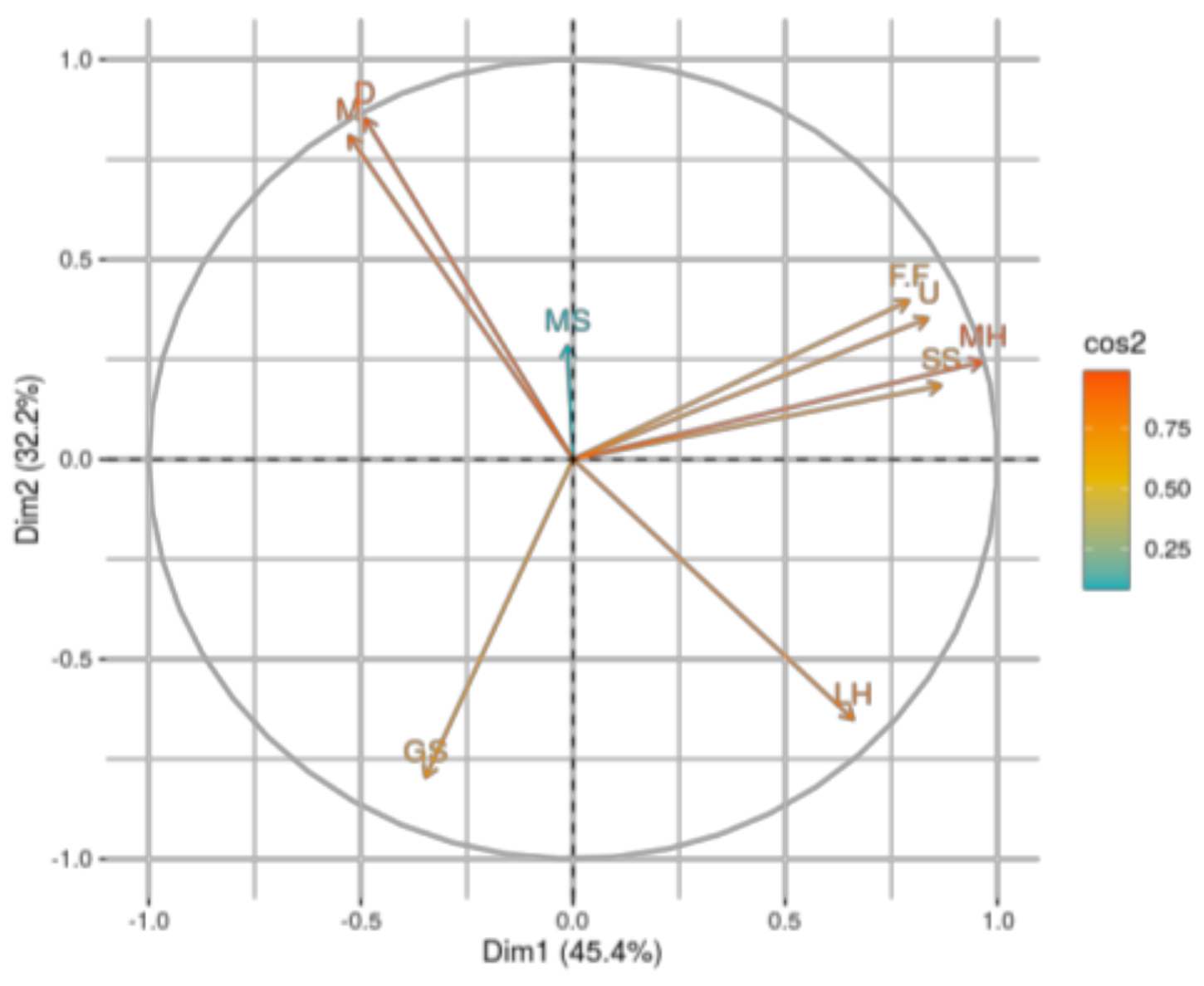
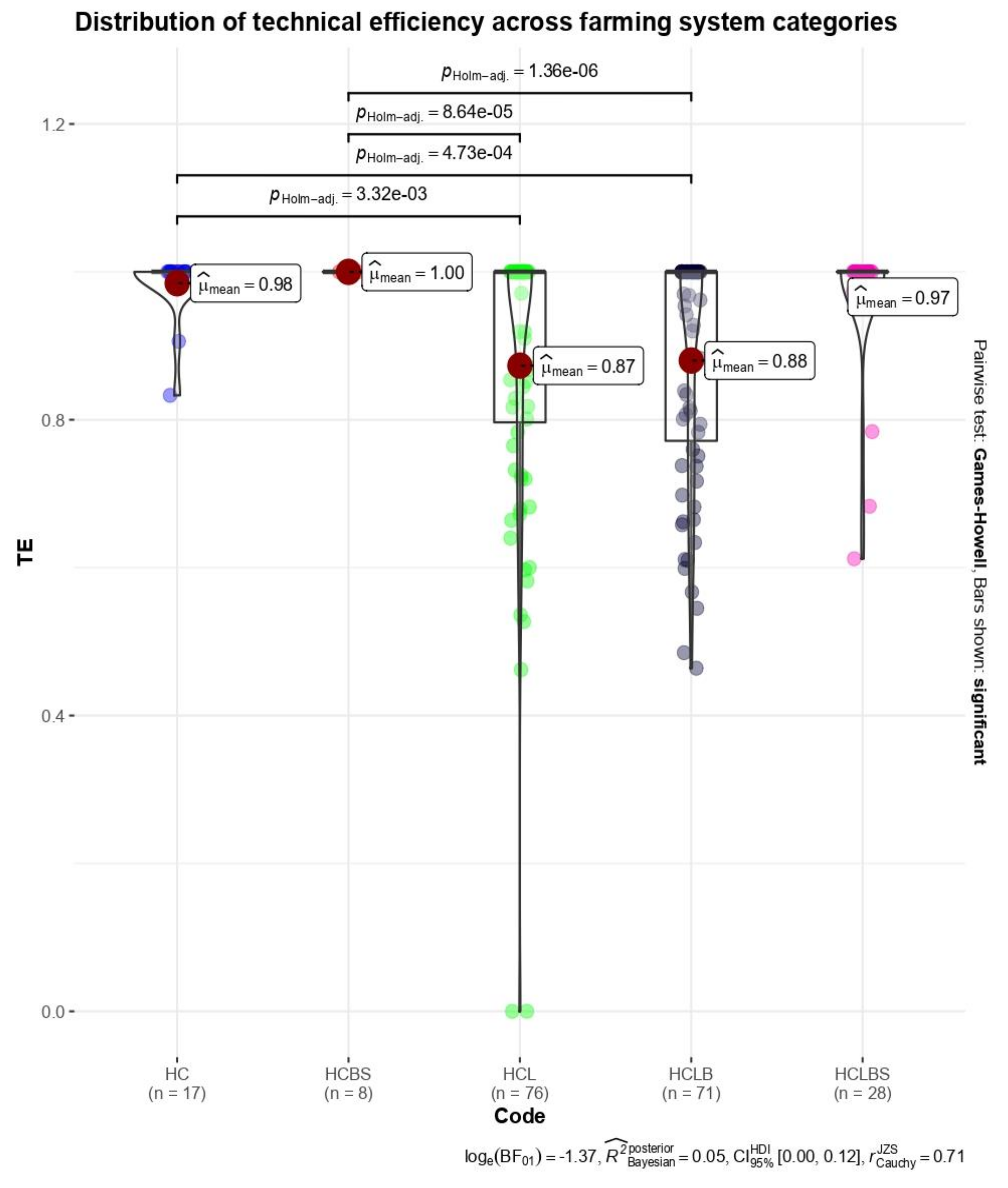

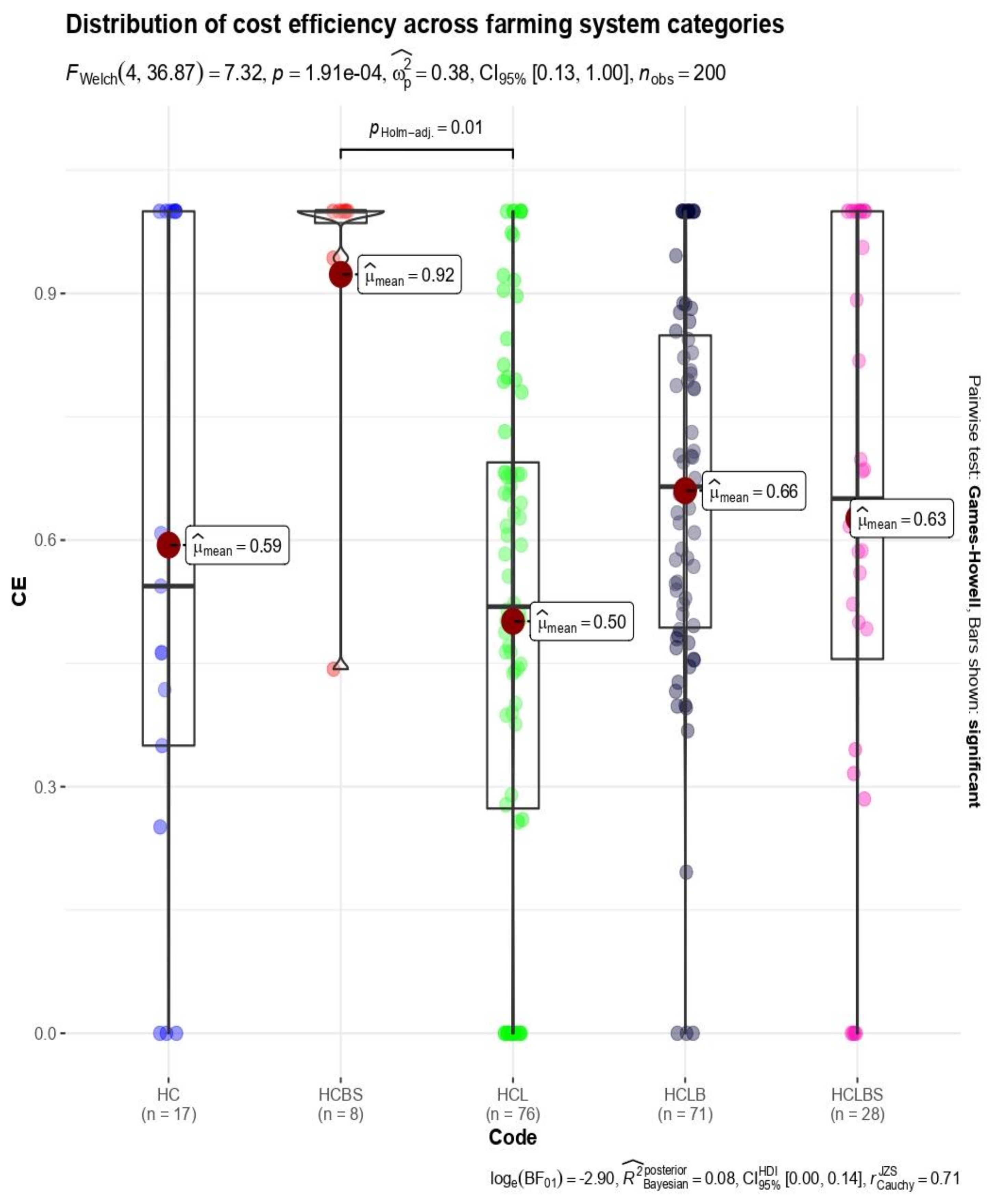
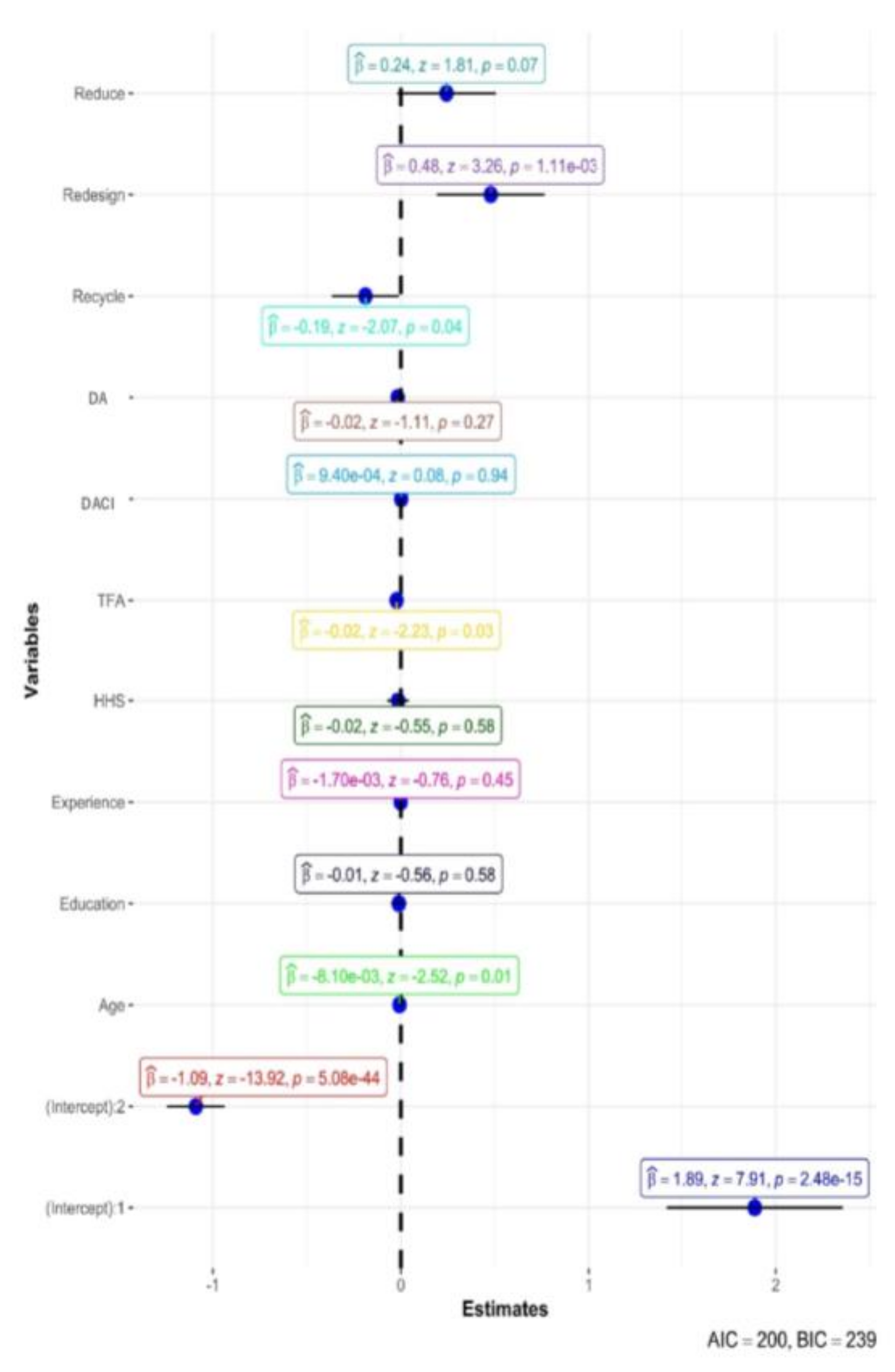


| Acronym | Variable Description | Unit |
|---|---|---|
| Sorghum seed (Ss) | Seed usage farm−1 year−1 | Kg farm−1 year−1 |
| Maize Seed (Ms) | Seed usage farm−1 year−1 | Kg farm−1 year−1 |
| Groundnut Seed (Gs) | Seed usage farm−1 year−1 | Kg farm−1 year−1 |
| Livestock, Birds Feed and fodder (F.F) | Feed/Fodder usage farm−1 year−1 | Kg farm−1 year−1 |
| Urea (Ub) | Usage per farm irrespective of crops | Bag farm−1 year−1 |
| SSP (SSPb) | Single superphosphate usage per farm irrespective of crops | Bag farm−1 year−1 |
| DAP (DAPb) | Di Ammonium Phosphate usage per farm irrespective of crops | Bag farm−1 year−1 |
| MOP (MOPb) | Muriate of Potash usage per farm irrespective of crops | Bag farm−1 year−1 |
| Machine | Tractor usage hours on farm | Hour farm−1 year−1 |
| Labour | Family labour, Regular Labour, Casual Labour usage hours on farm | Hour farm−1 year−1 |
| Acronym | Variable Description | Unit |
|---|---|---|
| Social variable | ||
| Age | Respondent in completed years at the time of investigation | Integer |
| Experience | Respondent in completed years at the time of investigation | Integer |
| Education | Number of years of formal schooling undergone by the respondents | Integer |
| Household size | Number of family members in the household at the time of investigation | Integer |
| Farm size | ||
| Total farm area | Land possessed by the farmers at the time of investigation was considered | Acre |
| Dryland area | Dryland area possessed by the farmers at the time of investigation was considered | Acre |
| Dryland area with contingent irrigation | Land with contingent irrigation facility possessed by the farmers at the time of investigation was considered | Acre |
| CE variables | ||
| Recycle | Replacing farm external input need through recycle of farm resource Viz., Farm Yard Manure (FYM), Vermicompost unit and through the heap of farm waste were considered and score were given between zero to one for DMU’s | Integer |
| Redesign | Farm that following improved and innovative management practices in diversified system (Ex: raking and baling biomass, innovative shed construction, corrugated shed waste disposal methods, following alternate cropping system than the traditional system, rain water harvesting methods, allowing livestock grazing for waste land management, and reducing the herbicide requirement of farm) were considered as redesign approach and score were given between the zero to one for DMU’s | Integer |
| Reduce | Reduced the use of external inputs (calculating farm nutrient flow and applying the required nutrient to achieve target yield, storing and reuse of farm produced seeds for next season, internal fodder production) were considered and scores were given between the zero to one for DMU’s | Integer |
| Prin_Comp | Eigenvalue | Percentage of Variance | Cumulative Percentage of Variance |
|---|---|---|---|
| PC1 | 4.086 | 45.404 | 45.404 |
| PC2 | 2.895 | 32.162 | 77.566 |
| PC3 | 1.503 | 16.702 | 94.268 |
| PC4 | 0.516 | 5.732 | 100 |
| Sorghum Seed (Kg farm−1) | Maize Seed (Kg farm−1) | Groundnut Seed (Kg farm−1) | Fodder/Feed (Kg farm−1) | Urea (Bag farm−1 (50 Kg) | DAP (Bag farm−1 (50 Kg) | MOP (Bag farm−1 (50 Kg) | Machine (Hrs farm−1) | Labour (Hrs farm−1) | |
|---|---|---|---|---|---|---|---|---|---|
| HCLBS | 7.08 | 10.60 | 10.29 | 3384.69 | 1.78 | 0.15 | 0.00 | 8.11 | 1127.00 |
| HC | 3.85 | 0.24 | 25.83 | 0.00 | 0.72 | 1.43 | 0.25 | 4.60 | 197.04 |
| HCLB | 12.73 | 0.85 | 33.89 | 2989.39 | 3.17 | 0.58 | 0.09 | 8.38 | 1040.30 |
| HCBS | 4.93 | 5.50 | 132.41 | 3.52 | 0.00 | 0.00 | 0.00 | 4.73 | 1210.73 |
| HCL | 6.70 | 39.75 | 50.61 | 3413.83 | 0.68 | 1.20 | 0.23 | 6.49 | 895.57 |
| Minimum | 3.85 | 0.24 | 10.29 | 0.00 | 0.00 | 0.00 | 0.00 | 4.60 | 197.00 |
| Maximum | 12.73 | 39.75 | 132.40 | 3413.83 | 3.17 | 1.43 | 0.25 | 8.38 | 1211.11 |
| SD | 3.43 | 16.39 | 47.99 | 1794.11 | 1.23 | 0.62 | 0.12 | 1.79 | 406.70 |
| CV (%) | 48.63 | 144.00 | 94.82 | 91.61 | 97.50 | 93.70 | 106.10 | 27.75 | 45.49 |
| Input Variables | Minimum | Maximum | Mean | Std. Dev | CV |
|---|---|---|---|---|---|
| Social variable | |||||
| Age (years) | 28.00 | 78.00 | 51.82 | 11.56 | 0.22 |
| Experience (years) | 2.00 | 60.00 | 26.48 | 13.79 | 0.52 |
| Education (years) | 0.00 | 6.00 | 2.43 | 1.72 | 0.71 |
| Household size (Numbers) | 2.00 | 7.00 | 3.12 | 1.05 | 0.34 |
| Structural variable | |||||
| Total farm area (Acre) | 0.50 | 17.00 | 4.13 | 2.82 | 0.68 |
| Dryland area (Acre) | 0.00 | 10.00 | 1.66 | 1.80 | 1.09 |
| Dryland area with contingent irrigation (Acre) | 0.00 | 17.00 | 2.40 | 2.58 | 1.08 |
| CE variable | |||||
| Recycle (Score: 0–1) | 0.00 | 1.00 | 0.85 | 0.36 | 0.42 |
| Redesign (Score: 0–1) | 0.00 | 1.00 | 0.12 | 0.32 | 2.78 |
| Reduce (Score: 0–1) | 0.00 | 1.00 | 0.10 | 0.29 | 3.09 |
Disclaimer/Publisher’s Note: The statements, opinions and data contained in all publications are solely those of the individual author(s) and contributor(s) and not of MDPI and/or the editor(s). MDPI and/or the editor(s) disclaim responsibility for any injury to people or property resulting from any ideas, methods, instructions or products referred to in the content. |
© 2023 by the authors. Licensee MDPI, Basel, Switzerland. This article is an open access article distributed under the terms and conditions of the Creative Commons Attribution (CC BY) license (https://creativecommons.org/licenses/by/4.0/).
Share and Cite
Balaji, G.A.; Geethalakshmi, V.; Senthil, A.; Prahadeeswaran, M.; Iswarya, S.; Rajavel, M.; Bhuvaneswari, K.; Natarajan, B.; Senthilraja, K.; Gowtham, R.; et al. Assessment of Economic Efficiency and Its Determents for Mixed Crop Livestock Production under Dryland Agriculture System in the Western Zone of Tamil Nadu, India. Sustainability 2023, 15, 8332. https://doi.org/10.3390/su15108332
Balaji GA, Geethalakshmi V, Senthil A, Prahadeeswaran M, Iswarya S, Rajavel M, Bhuvaneswari K, Natarajan B, Senthilraja K, Gowtham R, et al. Assessment of Economic Efficiency and Its Determents for Mixed Crop Livestock Production under Dryland Agriculture System in the Western Zone of Tamil Nadu, India. Sustainability. 2023; 15(10):8332. https://doi.org/10.3390/su15108332
Chicago/Turabian StyleBalaji, G. Arun, Vellingiri Geethalakshmi, Alagarsamy Senthil, Mockaisamy Prahadeeswaran, Sivakumarasamy Iswarya, Marimuthu Rajavel, Kulanthaivel Bhuvaneswari, Balakrishnan Natarajan, Kandasamy Senthilraja, Ramasamy Gowtham, and et al. 2023. "Assessment of Economic Efficiency and Its Determents for Mixed Crop Livestock Production under Dryland Agriculture System in the Western Zone of Tamil Nadu, India" Sustainability 15, no. 10: 8332. https://doi.org/10.3390/su15108332






